#3 in the Nugget Series
Flowers have closed up...next up, the fruit!
by Patty Guertin
July 8, 2015
Last updated 10/18/23
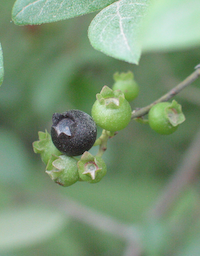
How can I tell if, and when, fruit starts to develop on my plant?
Watching your plant for the first signs of developing fruit can be tricky. An observer need only report "yes" for the "Fruits" phenophase when they are sure a fruit is developing. Each species' fruit phenophase definitions will define some detailed clues to watch for.
Your plant has flowered; what’s next? —the "Fruits" phenophase
A flower’s petals have closed up or dried up and maybe fallen off. What may be visible now is a small green or greenish flower part (if not obscured by dried flower parts or a plant’s floral anatomy). What is going on? What’s up next? Typically, fruit development immediately follows flowering in most flowering plant species (the Angiosperms) although there are a few exceptions. Knowing what to look for will help you when making observations for the post-flowering phenophase questions—the "Fruits" phenophases.
Just what is a fruit anyway? Certainly an apple, strawberry or pear? Yes—but it also is a sunflower "seed", a milkweed pod, an iris capsule, a rice grain, an acorn or a walnut, the "seed" inside a rose hip, and a maple tree’s tiny "helicopter seed".
Just to recap, the botanical definition of a fruit is the seed-bearing structure that develops from a flower’s ovary following fertilization of the flower’s ovules (the ovules are contained and hidden within the ovary of the flower’s pistil). That is, an ovary matures into a fruit which contains and protects the plant’s seeds that will be dispersed upon maturity. The type of fruit and stages of maturation and methods of dispersion are dependent and specific to the plant species. Please refer to the USA-NPN’s Botany Primer for more information.
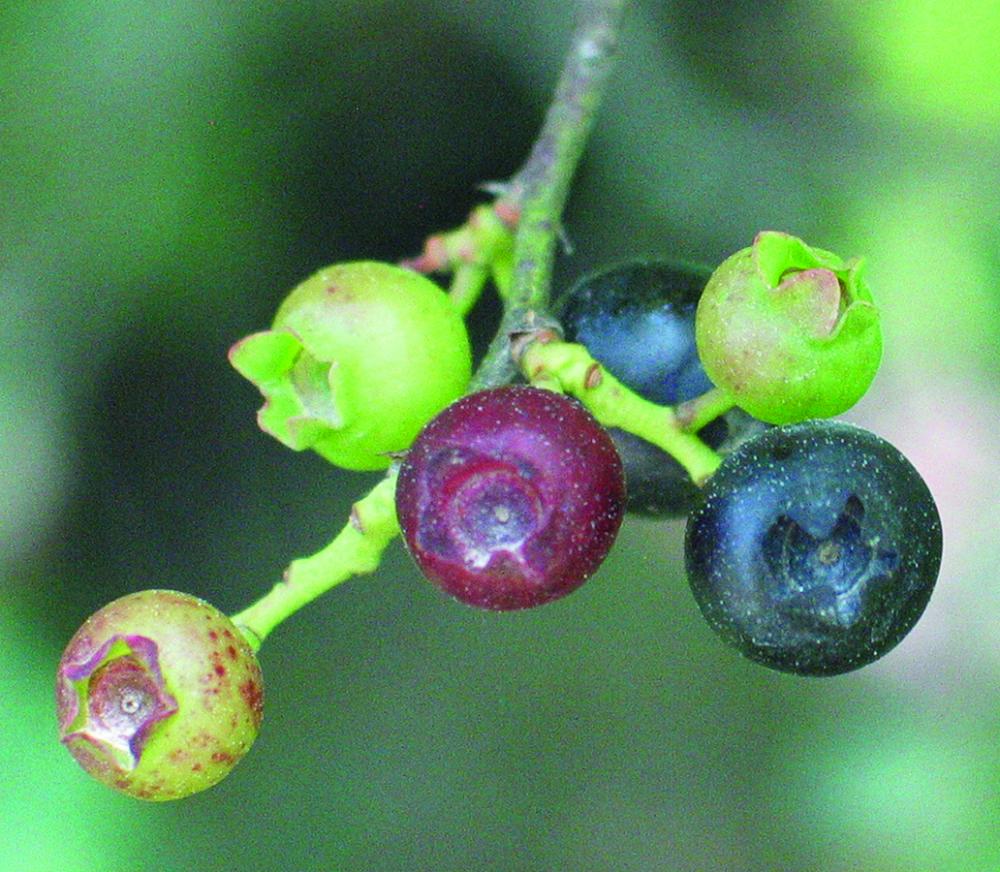
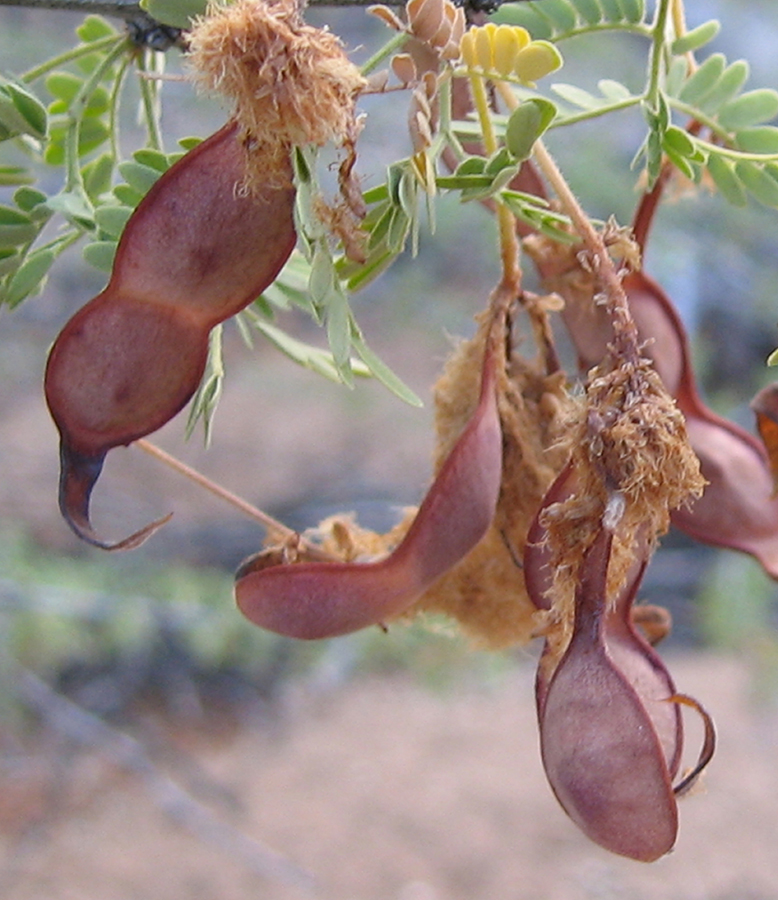
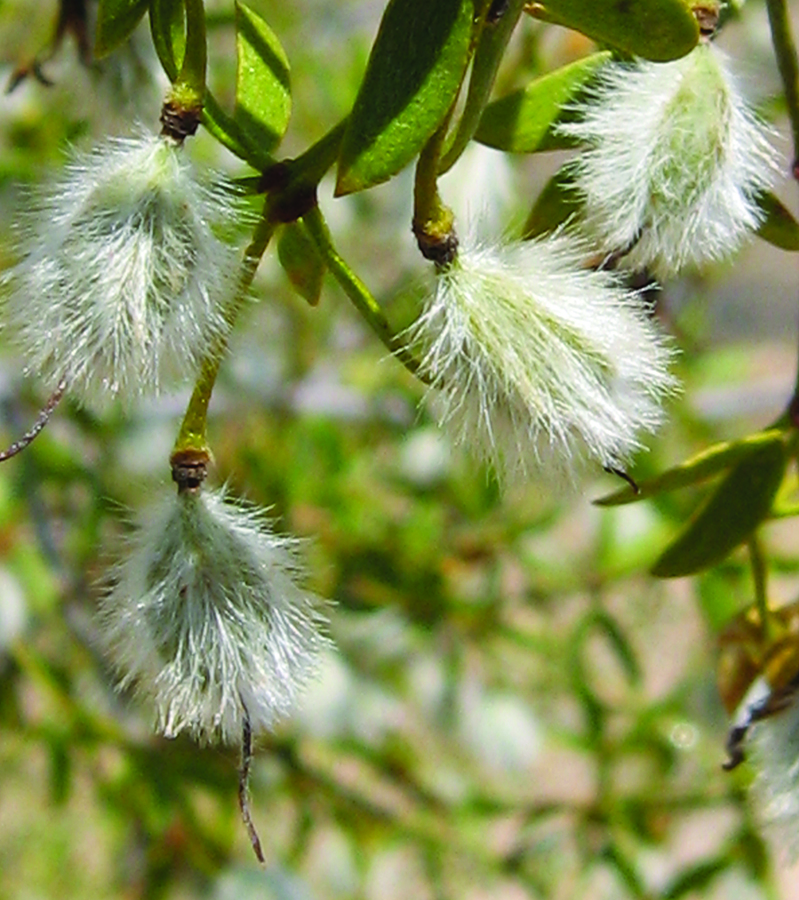
Fruits come in all sorts of sizes and shapes and types (e.g. sunflower "seed" versus a coconut, dry versus juicy or fleshy) and each type of fruit differs in its biological strategy of dispersal. Some float away on air currents or water, some catch onto fur and clothing with small hooks, some burst open explosively so the seeds are thrown far from the mother plant, some are eaten by insects and animals and carried to disperse the intact seeds in the animal’s droppings.
Nature’s Notebook "Fruits" and "Ripe fruits" phenophases
There are several observations we ask you to make regarding fruit phenophases; the first one simply asks if there is any evidence of fruit development on the plant, another asks about a fruit’s maturity, a third asks about fruit drop. Each plant species’ fruit phenophase questions found on that species’ profile page includes a description of what to look for specific to the plant’s fruit development. These descriptions accompany the fruit phenophase observation questions for both "Fruits" and "Ripe fruits". General cues to a plant’s dispersion method can be found in the "Ripe fruits" description. For this post, we are primarily focused on the "Fruits" observations and attempt to help you identify just when your plant is entering the "Fruits" phenophase.
Nature’s Notebook "Fruits" phenophase
An example of a "Fruits" phenophase description for a species might be: "One or more fruits are visible on the plant. For Vaccinium parvifolium, the fruit is a juicy berry that changes from green to pinkish green to pinkish-red or bright-red." Or, "One or more fruits are visible on the plant. For Bromus tectorum, the fruit is a tiny grain, hidden within tiny bracts and grouped into small clusters that hang on the end of branches along a drooping seed head, that changes texture from soft or watery to hard and drops from the plant. Do not include seed heads that have already dropped all of their grains."
The fruit description includes the general fruit type that you would see (e.g. juicy berry; tiny grain) and its color and/or textural changes (e.g. from green to pinkish green to pinkish-red or bright-red; changes texture from soft or watery to hard and drops from the plant).
The "Ripe fruits" phenophase observation questions includes more detail: "One or more ripe fruits are visible on the plant. For Vaccinium parvifolium, a fruit is considered ripe when it has turned pinkish-red or bright-red."
It can be tricky to identify just when a plant’s flower gets fertilized and starts to develop its fruits. You should keep in mind that not all flowers are successfully pollinated and fertilized; in those cases, a fruit will not develop. There also are instances where a fertilized flower that begins to develop into a fruit ceases development, and aborts the effort so the fruit will never ripen. We will focus on how you can assess these changes. This post is primarily meant to tell the general story of fruit initiation. For an observer, getting to know your plant species—and your particular plant—will help you to interpret the changes discussed here, from flower into fruit, for accurate observations. Don’t worry about reporting the exact moment it happens. The scientists who use your data understand there will be much variation in when observers first report seeing "Fruits" due to several factors. Get comfortable with how you can interpret the cues for the changes for your plant and report "yes" for the "Fruits" phenophase when you feel confident you are seeing fruit beginning to develop.
Floral anatomy and the position of the ovary...
Getting to know your plant’s flower anatomy will help with spotting the first indications of fruit development and saying "yes" to the "Fruits" phenophase. After the flower fades, you will need to look specifically at the ovary of the flower’s pistil. It helps to know where it is located within the flower—floral anatomy differs tremendously across species. (And some flowers can have more than one pistil, therefore, more than one fruit can develop).
Differing numbers of petals, sepals, pistils, and colors, and the placement of these parts in relationship to each other need to be considered. In watching for fruit development, if you know the position of the ovary in relationship to the petals, you can detect changes in the ovary a bit more quickly, that is, unless the ovary is obscured by flower parts or other factors. So, is the flower’s ovary placed below where the petals are attached, or above the attachment of petals?
Below are several examples of flower types (click on photos to enlarge). Photos a & b have ovaries situated above where the petals are attached within the flower (superior ovary), and photos c & d have their ovaries situated below where the petals are attached within the flower (inferior ovary).
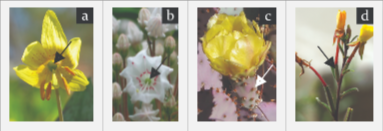
When you are looking at a plant to determine if fruit development has started, looking in the right place within a flower for the ovary will help with the early discovery of fruit development.
Following a flower’s pollination event and fertilization of the ovules...
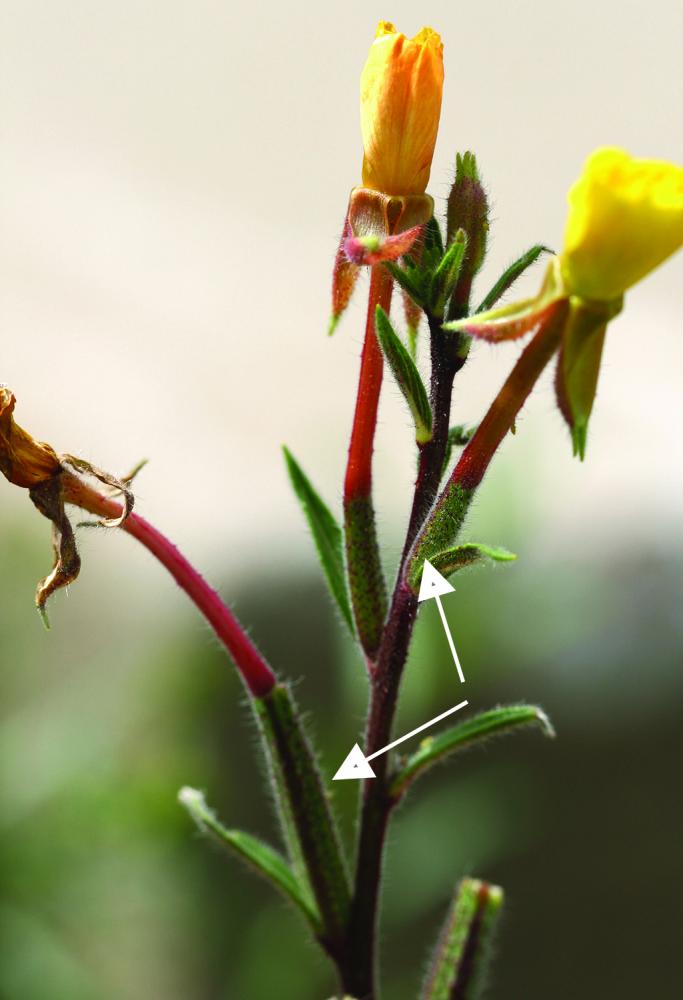
Following the event of fertilization the ovary will usually initiate development of its fruit. A careful observer can discern some changes, such as the ovary swelling, beginning to occur. This is an indication that fertilization in fact did occur, and the ovary, now called a fruit, is developing. With careful observations of a flower (you might have to use binoculars for flowers situated higher in a canopy) and taking into account the shape, color, and texture of a flower’s ovary just as a flower opens, you can compare what you saw during the flowering phenophases to what is happening to that ovary after the flower fades and the stigma and style of the pistil changes color, wilts, dries, or falls off (each species usually has a distinct pattern). Often these changes start happening very quickly. Take for instance, the species in the photo to the left.
For this particular species the flowers are short-lived. A new flower opens higher up on the flower stalk above recently closed flowers, but compare the ovary of the open flower to those flowers closed just below...They are already swelling and changing texture, just days later. In some species developmental changes can happen very quickly.
So, how do we know when a flower becomes a fruit?
For many plants, watching for the ovary to initiate swelling—following the passing of a flower’s display—is a sign that fruit is developing. In general, once a flower’s ovules are fertilized, fruit development begins. Below are several examples of sequences from flower to the beginning of fruit initiation and development. As a Nature’s Notebook observer, getting familiar with your species, understanding its anatomy, and observation experience will help to decipher the subtle cues that a fertilized flower displays when entering the fruit development stages.
1st set - Rhododendrons:
a) rhododendron flowers open, b) petals dropped and swelling ovaries exposed; white arrow—ovary beginning to swell but some observers may not be sure of what they are observing—so relax, and don’t report "yes" until you are sure; black arrow—ovary has continued to swell, and fruit development occurring
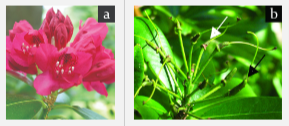
2nd set - Mayapple:
a) mayapple flower open, b) petals drying and swelling ovary is exposed but some observers may not be sure of what they are observing—so relax, and don’t report "yes" until you are sure, c) ovary has continued to swell, fruit development occurring, d) fruit has ripened

3rd set - Prickly pear cactus:
a) prickly pear flower closed, petals drying, b) petals dropped, white arrow—newly dropped petals and no evidence of ovary swelling; gray arrow—ovary beginning to swell but some observers may not be sure of what they are observing—so relax, and don’t report "yes" until you are sure; black arrow—ovary has continued to swell, and fruit development occurring, c) fruit has ripened
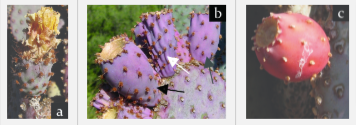
4th set - Penstemon:
a) one penstemon flower open and one flower with petals dropping, several other flowers' petals have dropped, b) white arrow—ovary beginning to swell but some observers may not be sure of what they are observing—so relax, and don’t report "yes" until you are sure; black arrow—ovary has continued to swell, and fruit development occurring, c) fruit has ripened, and has turned color and split open to release its seeds
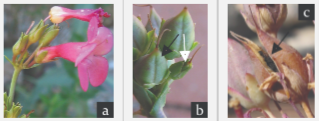
5th set - Acacia:
a) acacia flowers open (tiny flowers are clustered into a catkin), b) white arrow—flower parts drying; gray arrow—ovary beginning to swell but some observers may not be sure of what they are observing—so relax, and don’t report "yes" until you are sure; black arrow—ovary has continued to swell, and fruit development occurring, c) fruit continues developing, d) fruits near ripening

6th set - Saltbush:
a) white arrows—fourwing saltbush female flowers open and receptive (stigmas exserted); black arrow—ovary beginning to swell but some observers may not be sure of what they are observing—so relax, and don’t report "yes" until you are sure, b) ovary has continued to swell, and fruit development occurring, c) fruit has ripened

7th set - Oak:
a) oak flowers: white arrow—female flower developing but not open; black arrow—male pollen flowers developing but not open, b) ovary is swelling, and fruit development occurring, c) ovary continues to swell; fruit development continues, d) fruits have ripened and dropped from the plant
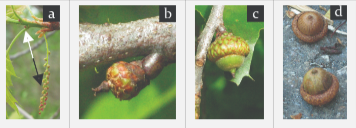
Just a note concerning plant species in which the flower parts obscure the ovary(s)...
In these cases, the descriptions for the fruit and ripe fruit will differ from those of the species we just covered, focusing on other clues the plant may give besides a visibly swelling ovary. For example, Eastern Mohave buckwheat "Fruits" phenophase: "One or more fruits are visible on the plant. For Eriogonum fasciculatum, the fruit is tiny and capsule-like, partially enclosed in a spent flower base (calyx), with many such spent flower bases tightly clustered together. The spent flower base changes from green to light brown or rusty brown as it dries out." It will take some practice with this plant, but it is not impossible. Knowing the flower’s anatomy, observation and a bit of experience with this plant is all one needs.
In contrast, some species’ fruit initiation and development has a very different sequence...
There are a few species that delay fertilization after pollination occurs. One such plant is witchhazel (Hamamelis virginiana). The plant typically flowers in late fall to early winter as the leaves are turning yellow and falling from the tree (photo a). The flowers are pollinated at this time, the petals fall, but the ovary enters into a dormant stage (photo b), and delays fertilization until the next spring when the new leaves are beginning to grow.

After spring fertilization, you will notice the ovaries begin to swell (photo c), an indication that fertilization has occurred and fruit development is beginning. They have now entered the "Fruits" phenophase. Again, if as an observer you are not sure of what you are seeing, wait just a bit for more evidence of ovary swelling—and wait to report "yes" for "Fruits" until you are sure. Photo d shows continuing development of a fruit, and photo e shows a fruit that has reached its ripened coloration, but still has yet to split open to release its seeds.
If you are observing a species such as this, and understand what you are observing on the plant, entering a comment into the record noting when the ovary is in a dormant phase will help others using the data to understand what is being observed despite prolonged periods of no apparent plant activity.
Other fruit development behaviors to be aware of...
One aspect of fruit development that an observer may experience is that of discontinued fruit development (abortion). This is when the plant stops development of the ovules for some reason. You will notice that the swelling ceases and perhaps a change in the "health" of the new fruit(s); possibly a change of color—an uncharacteristic yellowing or browning—or wilting or drying or simply dropping the green fruit from the plant. As you gets to know your plant, you will more easily detect these interrupted development occurrences. A note could be entered into the comments section of the plant’s record regarding this event, as you see fit. Most of the time this will not involve all of the fruits on a plant, unless some inopportune crisis has affected the plant.
An example of an aborted fruit effort, in the photo series below:
a) magnolia flower petals have dropped and the ovaries (with dried stigmas) are left, green but seemingly inactive within the cone-like cluster, b) ovaries are showing some swelling but it is still early, and some observers may not be sure of what they are observing—so relax, and don’t report until you are sure, and don’t report "yes" for "Fruits" until you are sure, c) ovaries have discontinued development, and the cone-like cluster has changed color from green to an uncharacteristic black-brown. No more swelling will be observed for these spent ovaries. No ripe fruits will result.

Just for comparison...
d) this photo captures what you would see if some of the flower’s ovaries continue fruit development. In this cone-like cluster some (but not all) of the ovaries within the flower have continued into fruit development, and what one would observe is "lumpy" growth. That is, swelling and continued fruit development for some of the ovaries of the cluster, but cessation of development for others within the same cluster, and e) Photo e captures further development, where some of the cluster's developing ovaries are beginning to change in color—towards their "Ripe fruits" colors.
Just a few more notes about Fruits and Ripe fruits phenophases...
So when do I stop reporting "yes" for the "Fruits" phenophase?
The Nature’s Notebook fruit phenophase questions are set up to report general and specific fruit conditions on the plant. The first phenophase question about fruits ("Fruits") simply asks if there are any fruits on the plant, but doesn’t take into account a fruit’s status. An observer should say "yes" if healthy fruits are present in any stage are on the plant, including fruits that have ripened (although do not include aborted fruits that are clearly discontinued their development). The second phenophase question asked specifically about ripe fruits ("Ripe fruits") on the plant. If an observer is answering "yes" to the "Ripe fruits" phenophase question, they also should be reporting "yes" to the "Fruits" phenophase question. Please refer to the USA-NPN’s Phenophase Primer for more information.
When can I be sure my plant’s fruits have ripened?
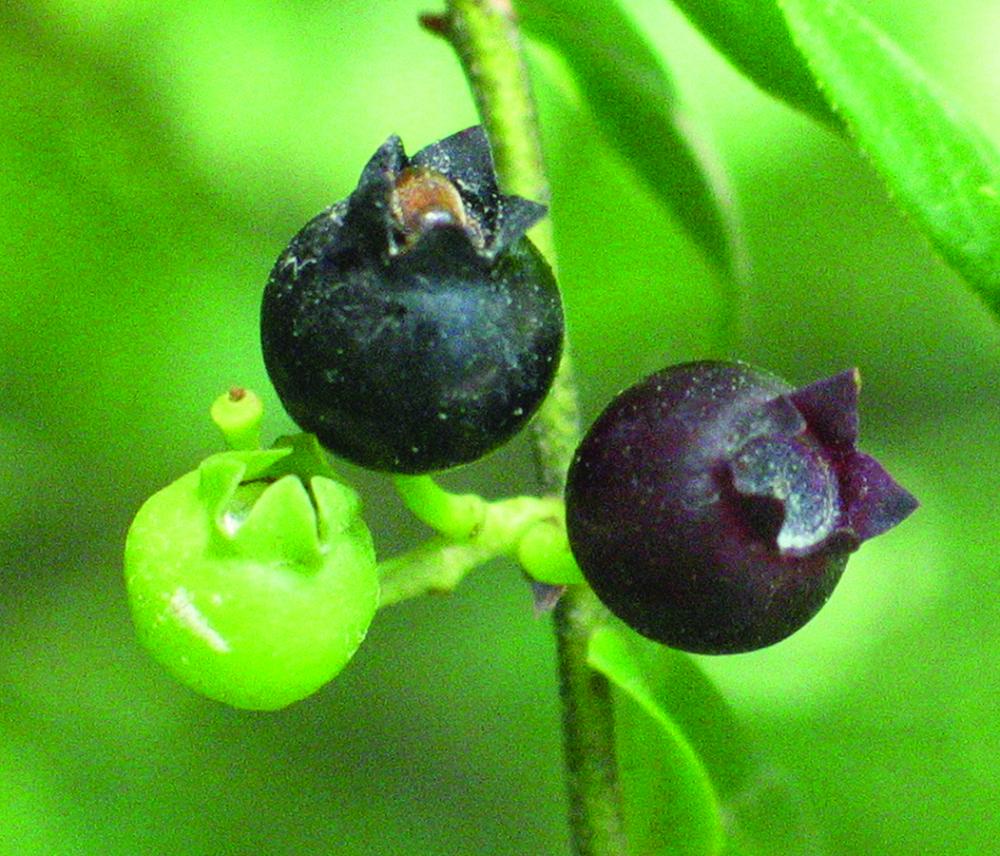
So your fruits seem to be ripe but the color isn’t as described and doesn’t quite fit the description given for the Nature’s Notebook "Ripe fruits" definition. Take for instance an example for highbush blueberry: "One or more ripe fruits are visible on the plant. For Vaccinium corymbosum, a fruit is considered ripe when it has turned blue or blue-black."
As you can see in the photo to the left, one of the ripe fruits is a red-black, and doesn’t quite fit the Nature’s Notebook species description for highbush blueberry of "ripe".
Even though Nature’s Notebook gives a researched description for ripe fruit—it is based on what others have reported. They have not seen your plant—which may differ given environmental influences and/or its unique genetic attributes. There is much variation in the plant world, often even within a species or variety. This includes the sequence in development of a particular species’ fruits. Get to know your own plant—and discover its own particular characteristics and behaviors. It might take a season or two, but your careful watching and experience will inform your phenophase observations. Make your best guess based on what you have come to understand about your plant, framed by descriptions and your own experience.
Good luck with all of your "Fruits" observations!